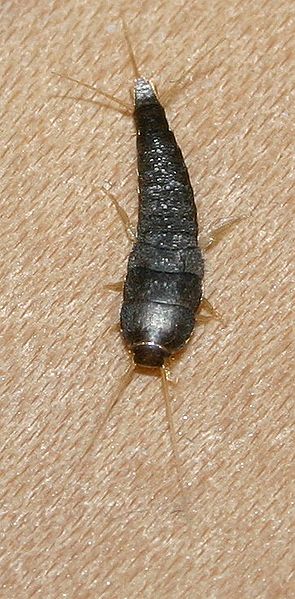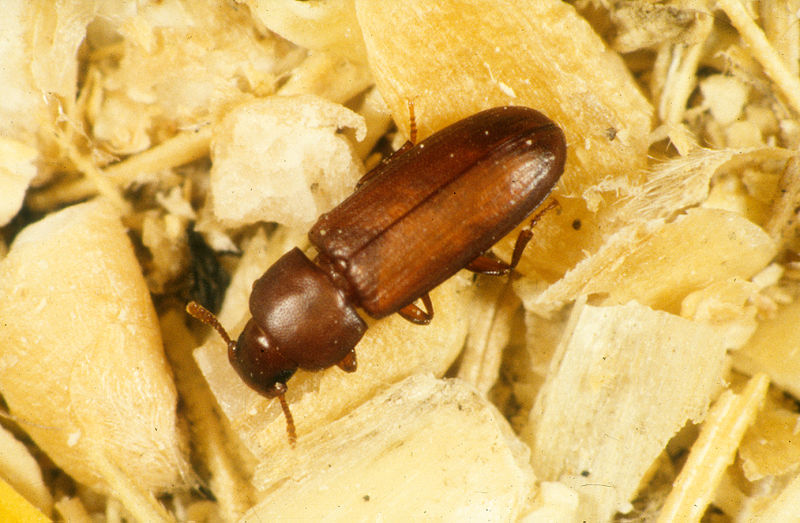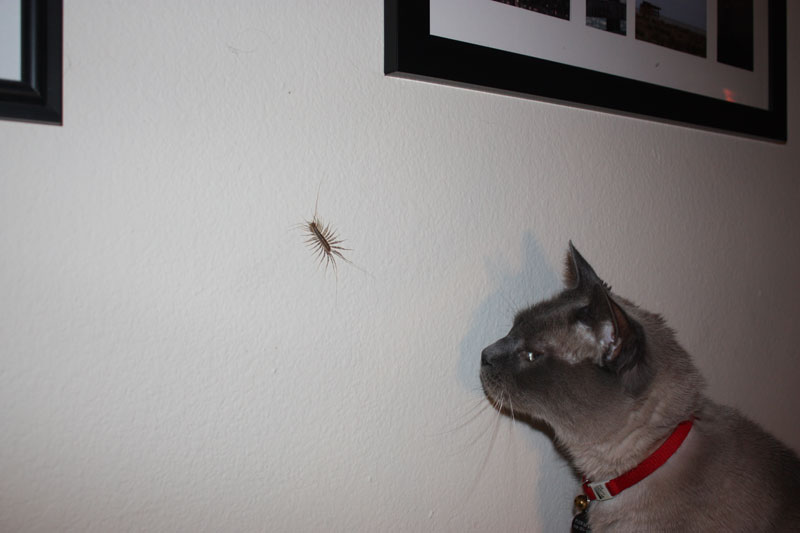In the various circles I have inhabited, I have always, always been the one who is most okay with creepy-crawlies. My friends and family alternately flee from or declare vengeance campaigns on the many-legged urban wildlife they encounter, unless I am around. Then, they notice the demanding smolder in my eyes and let me escort the errant creatures outside, away from insistent shoes.
It’s a cliché, but most of those creatures are not dangerous, only misunderstood.
The most important truism about arthropods is that they have very simple wants: food, shelter, and sex. Houses are actually exceptionally hostile to arthropods on most of those grounds. The open air of human homes with any kind of climate control is unacceptably dry for most insects and spiders, and food and water are highly localized and therefore surprisingly inaccessible. This varies between locales, and household bugs are a fact of life in the tropics where the water concern in particular is alleviated, but this basic fact remains true throughout. Arthropods, to a one, visit only places that give them access to something they want, and they visit them very insistently. Arthropods also outnumber us by orders of magnitude. That means that all of the traps and poisons in the world will not stop the flood of legs and mandibles if what they are actually after is not found and removed. So it pays to know a bit about the local insectosphere, and what each species says about the places where it appears.
Also, while an extremelydrafty house might cause the household wildlife to seek to share in humans’ body heat, ordinary insects and spiders do not have the kinds of suicidal instincts that would cause them to routinely seek out human proximity. They most certainly do not have any desire to fulfill that ridiculous chestnut about people accidentally eating eight spiders a year in their sleep. Insects that go after sleeping people are hungry parasites like mosquitoes and bedbugs, or predators like African driver ants that eat animals thousands of times their size. They are not ordinary spiders or roaches out on their daily travels.
 |
| Wikimedia Commons |
Some insects are seeking only shelter. People in temperate climes are well acquainted with the winter migration of various insects indoors, undertaken to protect themselves from cold. In my home, these are ladybugs, and they are generally doomed. Sheltering arthropods’ diets are rarely found indoors, drinkable water is rare, and the comfortable temperature means they don’t enter their usual hibernation phases and cannot dodge starvation or desiccation that way. My windowsills are littered with dried-out ladybugs. The cats cannot eat them quickly enough and bringing them outside only delays the problem. These animals are more nuisances than pests, and not even much of that. The biggest frustration was that our pet lizard and frog wouldn’t eat them—too crunchy—so this apparent smorgasbord was for naught.
Other insects come in looking for food. Most household pest insects are scavengers that feed on various forms of household detritus, and only reach serious numbers in homes where their preferred food items are easy to find.
 |
| Hein Waschefort, via Wikimedia Commons |
Houseflies, blowflies, and flesh flies (scary name for a harmless scavenger!) look for protein-rich human food and animal feces, and have a special fondness for rotting meat. Fruit flies, naturally, prefer fruit. Flies breed in masses of their food, so they rarely become established in homes unless trash bins are neglected for weeks at a time. This same proclivity makes them easy to purge, by taking out the trash. Fruit flies have a more rapid reproductive cycle, so they don’t take as long to establish breeding populations in trash bins, neglected fruit bowls, and other sources of fermenting plant material, but they are also drawn to easy-to-make wine and vinegar traps. Blowflies also have a habit of getting trapped in light fixtures and desiccating to death, even when expensive traps based on this premise are not available. Insects in general are meticulously clean animals, contrary to popular belief, but the habits of scavenging flies nevertheless expose them to all sorts of human pathogens, so it’s a good idea to get rid of them.
 |
| Hans Schneider via Wikimedia Commons |
In parts of Europe and in households that keep reptiles, crickets can become household pests. Exceptionally adaptable eaters, crickets eat any kind of plant material and resort to cannibalism if crowded and underfed. In parts of the world where they are native or established as invasive species, house crickets tend to migrate indoors or toward trash dumps and other sources of fermentation as winter sets in, seeking warmth. Crickets feed on accessible food waste, houseplants, and other plant-based foodstuffs, but their limited climbing ability means they tend not to attack trash bins. Crickets may breed indoors if a damp crevice or other water source is accessible to them, so a poorly-secured pantry can lead to a population explosion if their water needs are also met. Without such a water source, they rapidly succumb to desiccation, regardless of food availability. In the meantime, though, they sing, and that can get obnoxious fast.
 |
| Clemson University USDA Cooperative Extension Slide Series©Bugwood.org / |
Perhaps the quintessential household pest insect is the cockroach. In North America, the most common pest cockroaches are the small invasive German cockroach, Blattella germanica, and the giant American cockroach, Periplaneta americana, with the latter more common further south. The major nuisance of roaches, besides how their mere presence sets many people on edge, is their habit of defecating wantonly and the foul smell they leave behind when spooked. Universally, food availability draws cockroaches to a home, in the form of dirty dishes, food left out overnight, and unattended pet bowls. Roaches are extremely talented climbers, so they have much less difficulty accessing elevated food and shelter than many pest insects and can drink water directly from plumbing fixtures. This contributes to cockroaches’ well-deserved reputation of being difficult to dislodge from homes where they’ve taken residence. Roaches are also persistent pests because they have a very fast reproductive cycle and breed away from their food in sheltered, ideally damp crevices too small for many other insects’ comfort. In my experience, they particularly like breeding under refrigerators. Roaches will turn desperate if their previously reliable food sources go missing, such as after a concerted effort to maintain a clean kitchen, and may start eating seemingly inedible things like soap, bookbinding glue, and toothpaste; spending more time active during daylight when they would otherwise prefer to hide; and then resorting to cannibalism. Poison and glue traps are often effective against roaches, but the best way to keep their numbers down is to deny them food. Those that do not starve or get eaten by their fellows will seek out greener pastures.
 |
| Sebastian Stabinger via Wikimedia Commons |
In some places, silverfish are a common pest. These primitive insects are ancestrally wingless, rather than secondarily losing their wings like fleas and lice, and their strange appearance can make them confusing for onlookers. Like crickets, silverfish enter homes seeking warmth and plant-based food, but their need for water is even stronger. Silverfish often reside in bathrooms when they invade houses, relying on their persistent humidity and standing water. Silverfish have a reputation for destroying libraries, because of their ability to eat paper and bookbinding adhesives, but they also eat cotton- and linen-based clothing, bits of hair and dead skin found on floors, carpeting material and adhesives, and other seemingly unlikely sources of sugars. Because of this peculiar diet, getting rid of silverfish can be quite difficult. Drying out rooms where silverfish are doing damage can be helpful, but professional assistance is needed for difficult infestations.
 |
| CSIRO, via Wikimedia Commons |
Bakers both professional and amateur rapidly learn to loathe flour beetles. These small insects find (or arrive as eggs in) flour and other grains and breed rapidly, filling containers of stored flour with their grubs, feces, and shed skins. While not dangerous to humans in any way, they do lead to a higher-than-usual quantity of insect bits in baked goods, which may not be desirable, and they cause pantries to have a fine coating of beetle feces on most surfaces. Storing grains in sealed plastic containers rather than the paper bags in which most stores sell them will keep beetles out and will cause the ones that are already inside to asphyxiate, and roach traps are very effective at drawing out and poisoning the rest. In the meantime, baked goods that happen to contain now-dead flour beetles are not meaningfully different from baked goods that do not, so no harm is done. After all, specialty shops are selling baked goods made out of crickets now.
 |
| ArtMechanic, via Wikimedia Commons |
Earwigs are famous for scaring the daylights out of house-dwellers and gardeners who have not yet figured out that their supposed penchant for living in people’s ears or laying eggs in brains is an urban legend, and for their imposing but equally harmless abdominal forceps. Earwigs are more famous as garden than household pests, but can sometimes assume a role similar to crickets, eating plant material and hiding in moist crevices. Earwigs are more omnivorous than crickets, however, and also consume (in gardens) aphids and (in homes) roach nymphs and other tiny insects, so their presence is not always problematic.
 |
| RosierHR, via Wikimedia Commons |
Many other common pest arthropods are predators. Spiders, centipedes, and the occasional assassin bug move into homes for the same reasons other arthropods do, but they cannot establish themselves unless a source of prey animals is available. The spiders in my pantry feed almost exclusively on flour beetles, taking care of the ones that somehow evade the plastic bags and roach traps. In the winter, we sometimes get spiders building webs in the corners where the ladybugs congregate, and others build webs outside our windows to feast on caddis flies, blowflies, and mud wasps. Most places with “problem” centipedes have infestations of bedbugs, roaches, or silverfish happening in the background, providing the impetus for the carnivorous arthropods to linger. Targeting these creatures for removal is rarely useful and often actively counterproductive, because the insects on which they feast are often significantly bigger concerns than the predators themselves. The long-term presence of these predatory arthropods is, therefore, evidence that another arthropod is present in numbers, assuming this was not already known, and their disappearance generally follows the removal of their food source.
There are many, MANY other potential pest insects, but these are the likely candidates in my part of the world.
And then there are the real terrors. Some insects are genuinely hazardous to humans. Bedbugs, fleas, mosquitoes, and lice are as much a medical as a pest-insect concern, and termites and carpenter ants do serious damage to wooden structures. Fire ants, wasps, and bees can inflict painful bites and stings that kill many (mostly allergic) people every year, even if most hymenopterans are insufficiently aggressive to target people who are not directly harassing them. These are worth taking seriously, more seriously than consulting an enthusiastic and knowledgeable blogger for what amounts to overt medical and animal-control advice. The only suggestion this blogger will give about genuinely dangerous insects like these is to not leave standing water around in mosquito hazard areas, because they breed in it. You should probably also avoid sleeping on the ground during an African driver ant rampage.
For arthropods that are not arriving in response to a persistent draw like a trash bin, removing them alive and well from a dwelling and turning them loose outside is exactly as effective as killing them, and less messy. The challenge here is that capturing arthropods is often a multi-step process, but it is one that is easily learned. Arthropods in general are not very smart and have highly stereotyped responses to stimuli, so learning to predict their behavior does not take as much effort as one might think. That means that they tend to be drawn to particular areas of a dwelling, they tend to flee in particular directions when scared, and they have particular distances that they travel before assuming that they have evaded their harassers. Active fliers like blowflies tend to be trickier than more earthbound intruders like centipedes and beetles, but have the same kinds of patterns. Once one is used to a particular species’s pattern, it is not difficult to prod or lure it toward a flat surface, confine it against that surface with a cup, and slide a piece of paper or cardstock underneath to trap it. Some fast ground-dwelling beasts like centipedes are more easily caught from a trap that closes gradually, hitting the ground on one side and then “hinging” closed, while flies are more alert and require a trap that closes on all sides at once. Spiders tend to be particularly easy to catch, because web-spinners submit trivially to the cup and hunting spiders are rarely fast enough to get far. Once an arthropod is captured, dumping it outside might be as simple as taking the container outside and removing the cardstock, or it might have to be shaken into a bush. From there, they can generally find their way to more agreeable habitats, or get eaten by passing birds.
 |
| Jlauboro, via Wikimedia Commons |
Having a pet is another good way to deal with a low-level arthropod problem. Cats can amuse themselves for hours hunting insects, especially large, otherwise difficult intruders like wasps, taking care of them on their owners’ behalf. Some pet birds also eat insects (my chicken enjoyed moths and roaches), and most household insects are decent food for pet reptiles and amphibians. Small insects can sometimes work as treats for fish, but blowflies and some others have air-retaining hairs that let them escape water easily. It’s important not to combine insectivorous pets with poisoning the household vermin, though, and no pet is sufficient for dealing with a genuine or persistent infestation. Also, many pets have or develop preferences for particular arthropods and will refuse to eat certain kinds. Of course, poorly-maintained pets end up drawing vermin of their own.
Here as elsewhere, knowledge is power. Science has turned insects from a Biblical plague to a piece of the world ecology that we can manipulate with cardboard and chemistry. Far from fleeing from them as though they were intractable hazards, we should understand and coexist with them as befits us both. After all, numerically, it’s their world; we only live in it.


